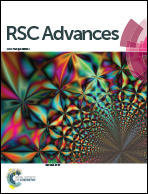Ultra-high Seebeck coefficient of a thermal sensor through entropic optimisation of ligand length of Fe(ii) spin-crossover (SCO) materials†
Abstract
In this work, we present a spin-crossover (SCO) complex molecular formulation [Fe(Ln)2](BF4)2 in an electrochemical single couple solution. A Seebeck voltage arises when an electrochemical single couple solution is subjected to a temperature difference, resulting in a single couple reaction at either terminal of the electrochemical cell. The ultrahigh Seebeck coefficients were obtained due to a number of molecular optimisation strategies. The [Fe(L16)2](BF4)2 complex demonstrated a maximum Seebeck coefficient of 8.67 mV K−1, achieved through a six-pronged approach to maximise entropy during the transition from low spin (LS) to high spin (HS) through: (i) a change in spin state, (ii) a change in physical liquid crystalline state, (iii) the spin Seebeck effect, (iv) the kosmotropic and chaotropic effect, (v) the fastener effect and (vi) thermal heat absorbance. A reduction of the Seebeck coefficient to 1.68 mV K−1 during the HS–LS transition at higher temperatures is related to the single spin state transition entropy change. In summary, this paper presents a systematic study to identify the contributing factors in the production of a sensor with an ultrahigh Seebeck coefficient for energy harvesting through the optimisation of its molecular entropy elements.


 Please wait while we load your content...
Please wait while we load your content...